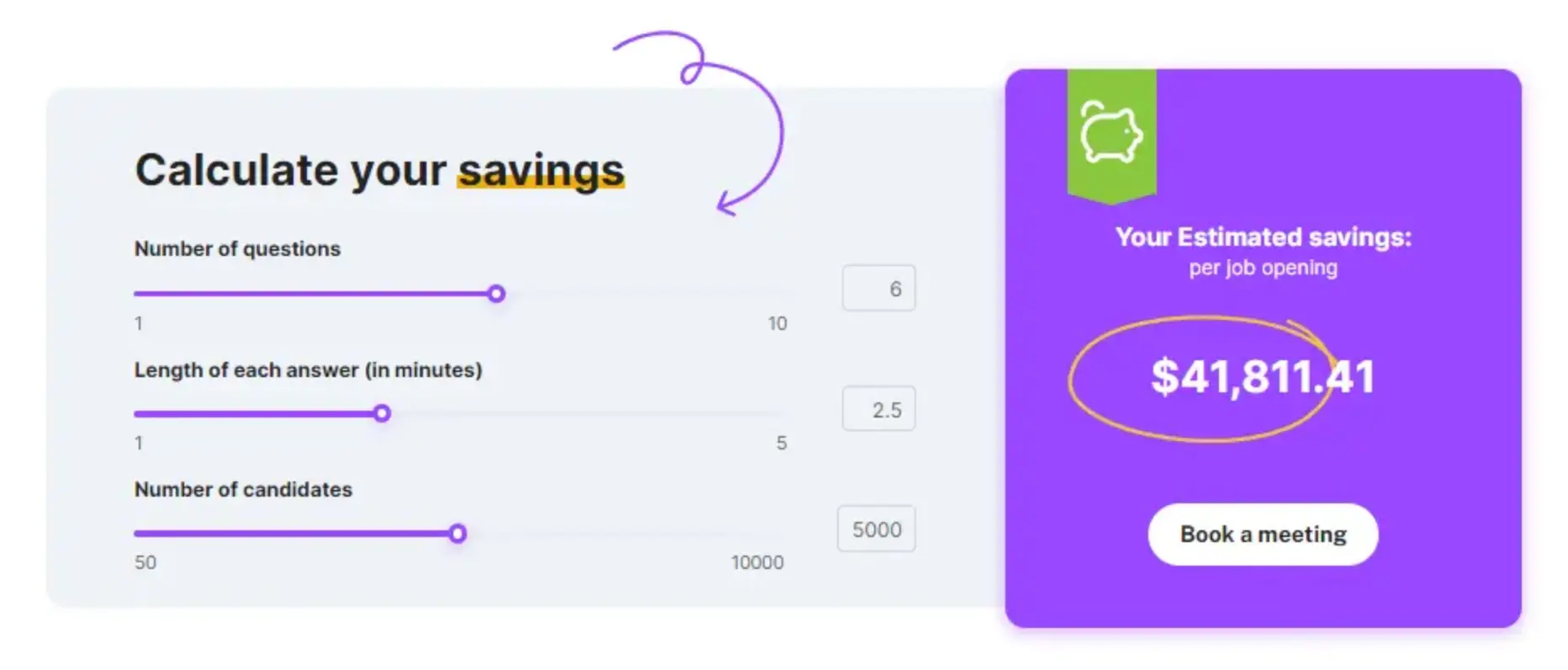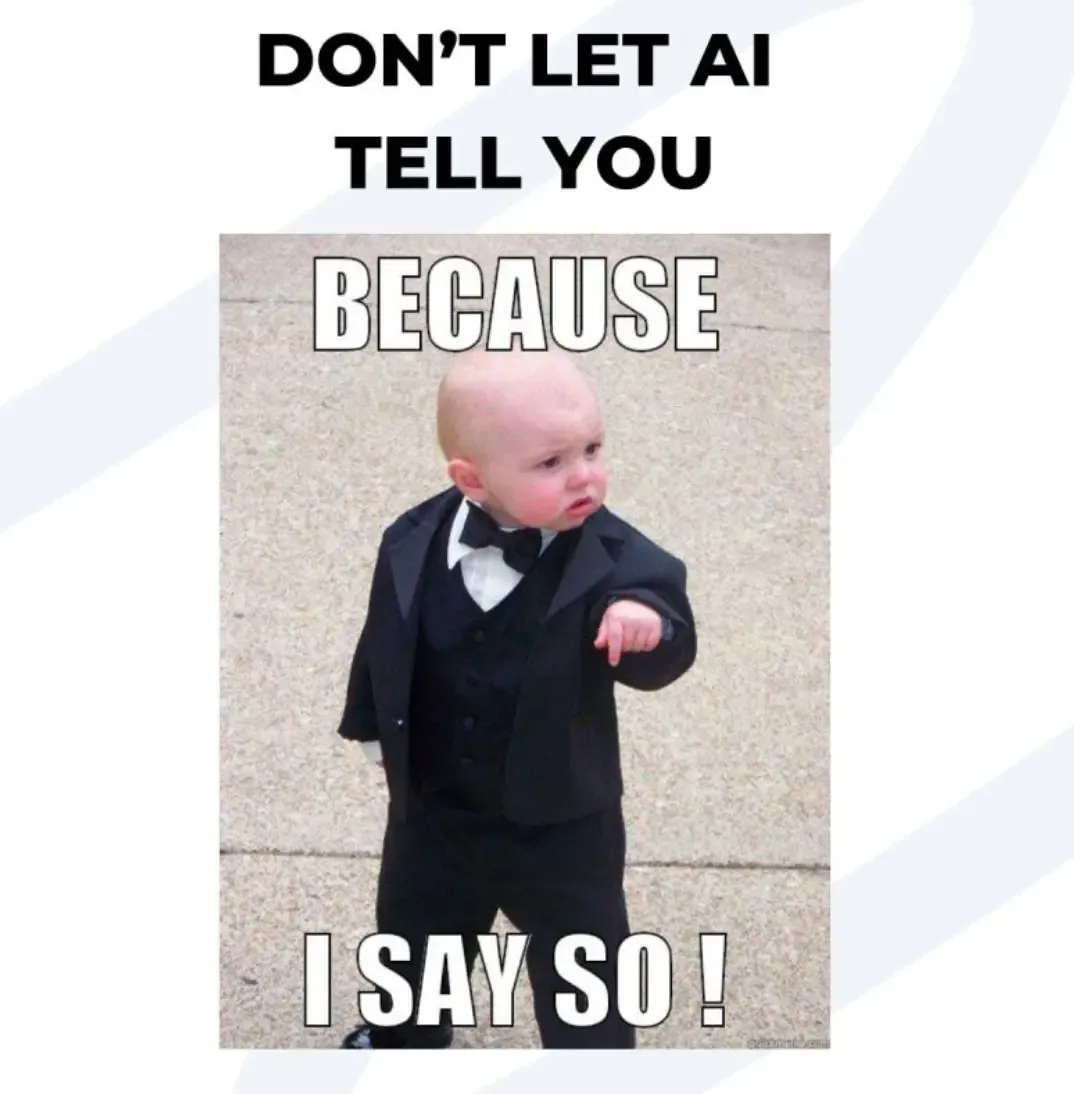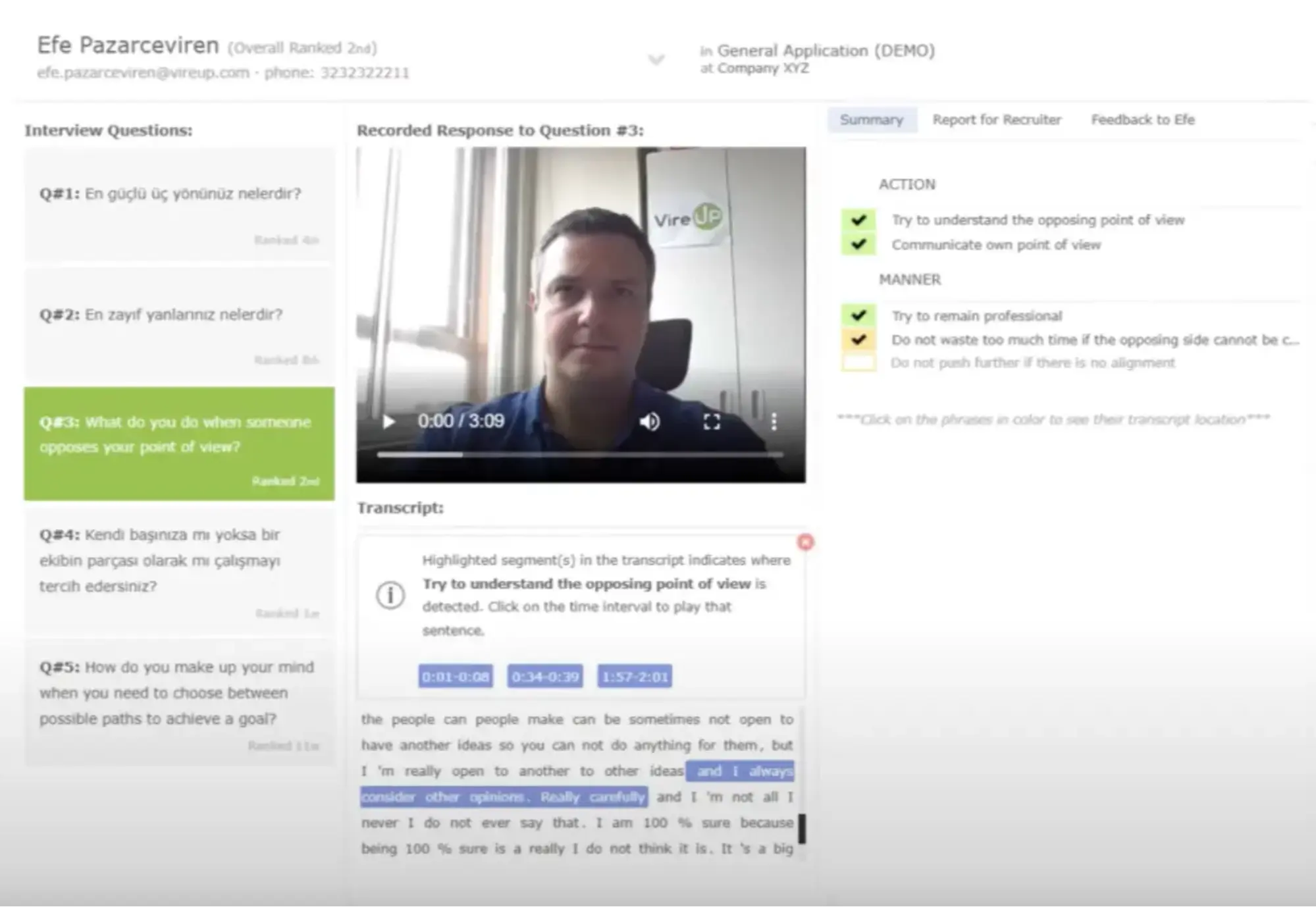With the number of job postings increasing, over 50% of recruitment professionals said that the most stressful part of their job is having more open roles to fill, which can be quite a time-consuming task.
You may want to give a fair chance to all candidates, but you risk ending in burnout after dozens of daily interviews. Even recruiters deserve to have a work-life balance, right?
That's where AI-powered video recruitment can step in to help you discover top talent. With new AI solutions, recruitment professionals can leverage technology to streamline their processes and alleviate the burden of conducting endless interviews.
In this article, we'll talk about using a video interview format to help you process more applications in less time and with better quality.
Video recruitment: 5 key things to consider
Here are some things to have in mind that will help both your HR department and potential applicants:
All viable candidates deserve a chance
We are all witnesses to changes that have been happening in the recruitment industry with the rise of remote and hybrid jobs that have allowed more people to apply for those jobs than ever before.
Recruiters are not sure how to process an increased number of applications in a limited time, and they’re often looking for shortcuts to help them filter candidates.
We at VireUp believe that employers should be extending the net broader instead of culling the applicant numbers. All viable candidates should be given a chance because some qualities and strengths aren’t obvious upon first impression, and by eliminating them early on, you might eliminate some otherwise excellent candidates. This is not just the ethical thing to do but it also makes great business sense.
But we also understand that it’s very hard to give an equal chance to everyone when you have thousands of applications to go through. That’s why we advocate for asynchronous instead of live interviews.
Yes, both of them are types of video recruitment, and both can be done online, but the biggest difference is that unlike live interviews, asynchronous video interviews don’t require scheduling and your whole recruitment team being present for every interview.
Using asynchronous recruitment videos, HR managers can get to know a larger number of candidates, much more than they would be able to interview during live one-on-one interviews.
How do asynchronous interviews work?
You send a set of questions to your prospective candidates that they have to answer by recording a video by themselves. They can do it on their own timeline, as long as they respect the deadline given by HR.
Now, you might think that interviewers end up with many hours of video content to review and give their opinion on. This doesn't have to be the case. If you opt for VireUp, you don’t have to watch and analyze video interviews if you don’t have time, as our software will do that for you.
Our explainable AI analyzes the whole interview, sentence by sentence, and provides you with a thorough evaluation of each candidate. The conclusions are justified with evidence from candidate answers.
That’s one of the ways our technology strives to automate the recruitment process, speed it up and allow you to give an equal chance to all candidates instead of focusing only on supposedly top candidates due to lack of time.
Also, AI-powered video assessment costs way less than conducting the same number of live interviews, as you can see in the picture below.
As an AI-powered automated video interviewing software, VireUp saves you both time and money! Our platform also offers a savings calculator, so you always know how much you've saved.
The calculator works in the following way:
-
You enter the number of questions you want to ask candidates, the length of each answer (in minutes) and the number of potential candidates.
-
The platform estimates how much money you'd save per job opening if you automate the process.

AI video recruitment savings
Keyword search, facial and voice recognition can drive bias
Yes, technology can help a lot when it comes to optimizing video interviewing and choosing the best candidates, but not all technology is good for the asynchronous recruitment process.
One of the most-used recruitment automation methods is keyword search, but you should take it with a grain of salt due to its limitations. This technology is based on the principle of transcribing videos sent by candidates and identifying keywords that best match the desired criteria.
The biggest issue with this approach is that keywords are not sufficient without understanding the context. For example, if you focus on "project management" as a key phrase, you wrongly reward a candidate who says, "I hate project management."
Another piece of technology to use with huge caution is voice recognition because it can unintentionally introduce bias in AI recruiting, such as:
-
Presentation bias: Voice recognition may interpret the shakiness of someone's voice or hesitation as something inherently bad and mark the suitable candidates as unfit for the position. Being anxious or having stage fright during an interview happens to many people, even if they're recording a video on their own, but that doesn’t say much about a candidate’s skills or character and shouldn’t be a reason to discard a candidate.
-
Demographic bias: Demographic bias can arise from various factors, such as accent or speech patterns, which may unfairly and systematically disadvantage specific candidates based on their demographic background or regional origin.
Finally, facial recognition is another technology that can create bias. The two biggest issues it creates are:
-
Racial bias: Facial recognition has trouble reading certain skin colors, like darker skin tones, which makes it inherently biased.
-
Superficial advantage bias: On the other hand, there are certain things that facial recognition sees as an advantage, for example, a bookshelf in the background or if prospective employees wear glasses. If the candidates are aware of these factors, they could potentially manipulate recruitment videos to their advantage, even though we all know that simply putting on glasses doesn't necessarily make one smarter.
One thing that sets our recruitment video software apart from other solutions is the use of NLP (Natural Language Processing) as a hiring technology.
NLP goes beyond simple keywords, as it understands the meanings of words in a sentence and the sentence itself. The focus is on concepts – for example, it'll interpret the expression 'I deliver results' the same way it would understand 'I achieve goals'.
It analyzes a recruiting video to match the sentence with the criteria of a hiring manager and easily recognizes what kind of concepts a recruiter looks for in sentences. That way, recruiters can analyze recruitment videos on a much deeper level and avoid bias.
Skills-first hiring can increase the talent pool by up to 20 times

Skills graphic
A traditional approach to hiring largely relies on employment history and traditional education achievements to identify, select and filter out target candidates.
However, conventional indicators like years of experience and traditional degrees are unreliable predictors of one's competence in performing a job effectively. Numerous employees still face barriers to accessing higher education learning opportunities, which doesn't mean they haven't developed the desired skills in the non-formal setting. And vice versa – having a degree doesn't necessarily make qualified candidates.
Therefore, it's time to reconsider our approach to recruiting and developing talent and instead of focusing on outdated criteria that may cause us to overlook candidates with non-traditional career paths or skills gained through self-learning, use the skills-first hiring approach.
Here are some benefits of this hiring strategy, both for employers and job seekers:
- Broader talent pool: You can access a broader and more diverse talent pool whose skills are applicable across various industries, regardless of their education. In fact, a 2023 LinkedIn study showed that a skills-first approach to hiring could significantly increase the talent pool and attract up to 20x more eligible workers than the traditional approach.
- Reduced hiring time: This highly targeted approach and prioritizing skill assessments help you to streamline the hiring process and find the right candidates quickly. Saving time also applies to candidates: when LinkedIn began notifying job seekers that their skills aligned with job postings, it was discovered that those who applied to positions matching their skills achieved greater success in securing employment with fewer applications.
- Reduced costs: Shorter hiring cycles can result in significant savings associated not only with recruitment but also with employee onboarding and training. It has a positive effect on many key recruitment metrics, but time and money are the most important ones.
- Increased employee engagement: Hiring people based on their skills and competencies often leads to employees who are more motivated to improve those skills further, resulting in higher levels of engagement and job satisfaction.
Here's how to implement the skills-first approach and make it a part of the company's culture and values:
- Understand the skills necessary for your company: You should start by identifying the skills necessary for both current and future roles in your company. For a moment, step away from traditional roles and job titles and focus more on figuring out what type of skills are needed to complete certain tasks.
- Use skill-assessment software: Skill assessment is a crucial part of pre-employment tests, but the good thing is that it can be automated with this type of tool, whether you want to test someone's language knowledge or technical skills.
- Invest in employee development: You should support employees who want to further develop their skills and provide them with adequate training, courses and mentors aligned with their career growth opportunities.
VireUp uses this approach actively in the hiring process as we believe that the best candidates are those who have the right skills for the role, not just education.
That’s why our platform allows you to create competency-based questions suitable for different industries and positions. You can screen and benchmark candidates against identical questions showcasing their skills, which not only speeds the assessment process but also makes sure that it’s fair and objective.
AI conclusions should be explainable and auditable
When you start using AI recruiting tools to improve your decision-making process, it's crucial to implement technologies that provide you with the answer as to why a certain conclusion related to the hiring process was reached.
Don’t know about you, but for us, one of the most frustrating things about working with AI is when it presents us with an argument or a definite conclusion that lacks WHY and HOW. Without WHY or HOW, users may understandably question the accuracy and reliability of the output or wonder whether relevant factors were considered in the decision-making process.

AI meme
That’s why we specifically focus on explainable AI. Our explainable AI goes above and beyond by evaluating each sentence comprehensively.
Behind every conclusion displayed on your dashboard lies a detailed, logical explanation you can review and analyze with your team. With this feature, you can even examine both positive and negative evidence of traits that may not have been part of your initial criteria.
VireUp has a clear, visual dashboard presenting the ranking of all applicants. If you want to, you have the option to dive into each candidate's profile and responses at a sentence level for further details.
VireUp's dashboard serves as a substitute for the traditional interview evaluation form, allowing you to track all criteria in a single place.
Our software automatically highlights sections of the transcript that align with your hiring criteria, providing explanations for its logical conclusions that you can either approve or decline. The report also identifies potential red flags, signaling potentially risky or concerning segments of statements that you can further explore.
Don’t worry – our software doesn't make hiring decisions on your behalf!
It serves as a tool that supports your decision-making process, enabling you to make the most informed choice by identifying exceptional candidates and streamlining HR tasks such as conducting interviews.

VireUp video recruitment analysis
Excellent candidate experience can position you as an Employer of Choice
The recruitment process can shape the first impression that candidates get of your company culture, which profoundly influences their employee experience and the decision to work with you.
At VireUp, we strive to create a pleasant and effortless recruitment experience for the candidates, which can strengthen your employer brand. Here's what makes us stand out from other software products in terms of candidate experience:
- Time flexibility: We make sure that your candidates have the best recruitment experience by offering them the possibility of having the interview whenever it suits them. They don't have to come to a scheduled interview or record recruiting videos the moment they get the questions, but whenever the time is right for them.
- Guidance: We also make sure that your candidates understand what the entire process looks like because we believe that transparency leads to the best possible results and the best recruitment videos. This is where we make a difference, as the traditional way of hiring employees leads to candidates being left in the dark while we provide them with tips on how to create a great recruitment video that benefits both candidates and employers.
- Coaching-level feedback: All applicants can get personalized coaching-level feedback as a result of our analysis, so they'll know what to work on in the future.
Also, our software includes a candidate satisfaction survey to get actionable insights to help you improve your screening process.
Thanks to the way we approach the candidates and the recruitment process, the candidates from different industries consistently rate our platform and their overall experience at over 4 out of 5 stars.
Conclusion
It's no secret that many companies are switching to asynchronous recruitment videos instead of scheduling traditional candidate interviews, as a way to evaluate more candidates in less time and scale their recruitment process.
Embracing technologies like VireUp that prioritize skills-first hiring can revolutionize the recruitment process, offering benefits for both employers and candidates.
Features like explainable AI and the use of natural language processing ensure transparency and accountability in the decision-making process, mitigating bias and promoting fairness.
When you pair this with an exceptional candidate experience aligned with your company values and coaching-level feedback, it's clear that our software helps position you as the employer of choice.
If you're ready to streamline your hiring process and find perfect candidates for your company, book a free demo to see how we can help you.

